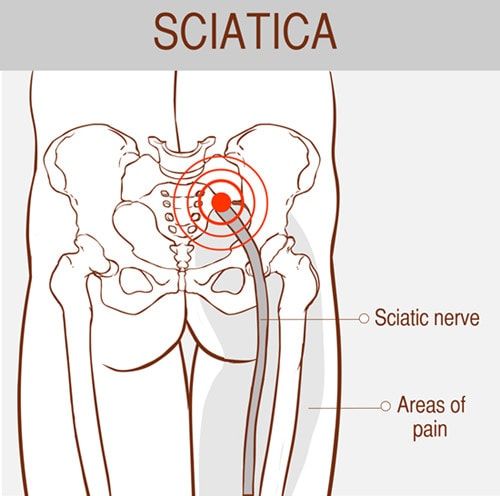Sciatica is a popular buzz word nowadays even though most people aren't clear on what it means. The sciatic nerve is a large branch that originates from the bottom of the spinal cord. It runs through the butt and down the entire back of the leg. It has smaller branches throughout the back of the leg and then breaks into two main branches in the lower leg. These run down the side and back of the calf and into the bottom of the feet and toes.

Signs of nerve damage.
Nerves are meant to send and receive signals from the areas of body they run and branch through. They are very sensitive to excessive pressure and/or stretching. Damage to them can lead to sensations of burning, tingling, shooting pain, and numbness anywhere along the pathway of a nerve. With more severe cases, the symptoms can radiate down an entire nerve path and can also be accompanied by muscle weakness.
Sciatica causes very specific symptoms.
Sciatica is simply irritation of the nerve (typically one side at a time) somewhere between the low back and the knee. This irritation can be caused by a whole array of health issues, including a bulging disc (for more causes, look here). One of the most common symptoms is shooting pain into the butt. A common misconception about sciatica is that it can directly cause hip, general low back or front of the thigh pain. Sciatica is very specific and traceable to its pathway through the back and legs.
The statistics of sciatica.
This type of pain is most common with prolonged sitting, obesity, pregnancy and a sedentary lifestyle. It has been found that most cases of sciatica spontaneously recover with basic therapy and use of anti-inflammatory medications (talk to your doctor if needed). The good news is that you can do a lot of treatment on your own at home that doesn't require any drugs.
Try these 6 simple activities to start getting relief now.
1. Stretch
Muscle guarding and tension can put excessive pressure on the nerve. The most common areas of tension with sciatica are the butt, hamstrings and low back. Hold each stretch for 60 seconds 2-3 times.
a. Butt stretch.
In sitting bring the outside ankle of the affected side to the opposite knee and hold. (If you need a stronger stretch scoot your butt toward your heel on the ground.)
b. Hamstring stretch.
Lying down, bring the knee toward the chest until you can reach behind the thigh with your hands (use a towel or strap if you can't reach). Then gently straighten the knee until a stretch is felt in the back of the knee.
BONUS: Try gently moving the ankle while in this position to more specifically target the sciatic nerve all the way to your toes. (Do not force it or continue if it aggravates symptoms.)
c. Low back stretch.
Start on your hands and knees and bring the butt toward your heels until a stretch is felt to gently release the low back.
2. Posture
Avoid leaning to one side or a forward bent posture during your day since it will exacerbate pressure and muscle guarding. Find a balanced, well supported posture with your daily tasks that you can maintain comfortably. Additionally, moving in and out of various postures is important to keep pressure off sensitive areas for prolonged periods of time (try a standing desk if you're working). Don't forget about your posture throughout the day with things like sleeping, sitting in your car or on a couch.
3. Massage the Sore Area
As with stretching, being able to alleviate muscle tension can decrease the pressure being put on the nerve. The first step is finding the sore area. This may seem obvious but the pain may be hard to pinpoint until you poke around a little to find the "hot spots." Once you have found them attempt to apply direct pressure to this area with your hand or a tennis ball. A common hot spot is right in the center of the butt muscles (where the top corner of your jeans pocket would be). This is a great spot to try using a tennis ball; simply sit on it and roll around. The amount of pressure you apply is dependent on how much you can tolerate while staying relaxed and not aggravating symptoms.
4. Check your strength and exercise.
Core and butt strength matter for muscle balance. Plus targeted exercises promote circulation to these sensitive tissues to promote healing. Nerves can become damaged quickly so promoting blood flow can make a big difference. Try these exercises as a good starting point (especially #4 and #5). Exercise can also be as simple as walking, as long as you can minimize limping and it doesn't make symptoms worse.
5. Decrease inflammation.
All of the above steps will help with inflammation through circulation and relaxation. For an extra boost, try using an ice pack on the sore affected area for 10-20 minutes. Keep it on just long enough for the area to go numb. You can try alternating with heat for 10-20 minutes throughout the day to promote relaxation. Try to always end your treatment sessions with ice since it is most beneficial for anti-inflammatory effects.
Ultimately, try these and see what works. It doesn't matter what you read or see, you have to modify and do what feels right for you. The best part is that there is no risk involved with these steps, they will only be helpful as long as you listen to your body. Remember to seek medical help if it doesn't gradually improve, symptoms get worse or it has lasted longer than 6 weeks.